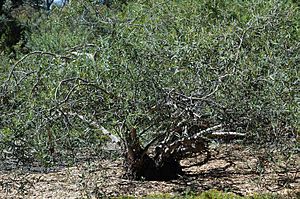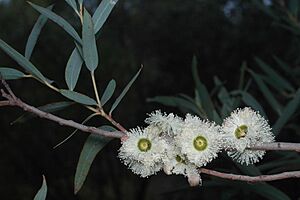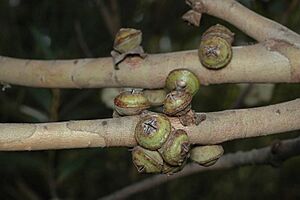Mongamulla mallee facts for kids
Quick facts for kids Mongamulla mallee |
|
|---|---|
 |
|
| Eucalyptus deuaensis in the ANBG | |
| Scientific classification | |
| Genus: |
Eucalyptus
|
| Species: |
deuaensis
|
The Mongamulla mallee (scientific name: Eucalyptus deuaensis) is a special type of mallee or small tree. It is found only in a small area of New South Wales, Australia. This plant is known for its smooth bark, long leaves, and pretty white flowers. It also produces interesting bell-shaped fruits.
What Does It Look Like?
The Mongamulla mallee is a rare plant that usually grows as a mallee. This means it's a shrubby tree with many stems growing from the ground. It can also be a small tree, reaching about 4 m (13 ft) tall. Its bark is smooth and can be white, pink, or yellow. This plant has a special woody swelling at its base called a lignotuber. This helps it regrow after fires!
Young plants and new shoots have leaves that are egg-shaped to lance-shaped. These leaves are about 35–75 mm (1.4–3.0 in) long and 13–23 mm (0.51–0.91 in) wide. They grow in pairs directly opposite each other on the stem.
Older, adult leaves are arranged alternately along the stem. They are the same color on both sides and are shaped like a spear or slightly curved. These leaves are about 70–100 mm (2.8–3.9 in) long and 10–23 mm (0.39–0.91 in) wide.
The flower buds grow in groups of seven where the leaves meet the stem (called leaf axils). They are on a short stem called a peduncle, which is up to 4 m (13 ft) long. Each bud sits directly on this stem without its own little stalk.
When the buds are ready to open, they are diamond-shaped, about 8 mm (0.31 in) long and 6–7 mm (0.24–0.28 in) wide. They have a cone-shaped or pyramid-shaped cap called an operculum.
This plant has white flowers. People have seen it flowering in January and November.
After flowering, the plant produces woody fruits. These fruits are shaped like a bell, half-sphere, or cone. They are about 5–6 mm (0.20–0.24 in) long and 10–15 mm (0.39–0.59 in) wide. The parts that open to release seeds (called valves) stick out from the fruit.
How It Got Its Name
The Mongamulla mallee was first officially described in 1987 by two scientists, Douglas Boland and Phil Gilmour. They studied a plant found "near Mongamulla Mountain, Deua National Park".
The scientific name deuaensis comes from Deua National Park, where the plant was discovered. The ending -ensis is a Latin suffix that means "from a place" or "belonging to a country." So, deuaensis means "from Deua."
Where Does It Live?
The Mongamulla mallee is only found in one specific place: Mongamulla Mountain. This mountain is located inside Deua National Park in New South Wales. It likes to grow on steep, rocky cliffs.



